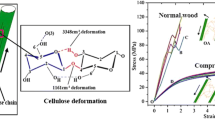Summary
Compression wood (CW) of the giant sequoia studied had higher values than normal wood (NW) in crushing strength and ultimate stress in tension parallel to grain, in toughness, in modulus of rupture, and in work to maximum load and total work in static bending. In the green condition CW had higher values than NW in stress at the proportional limit and work to the proportional limit, and about the same modulus of elasticity in static bending. In the dry condition CW was about equivalent to NW in work to the proportional limit, but was slightly weaker in stress at proportional limit and modulus of elasticity in static bending. The compression wood of this giant sequoia, even though formed when the tree was suppressed and having relatively narrow rings, can therefore be said to be essentially equivalent to normal wood so far as the mechanical properties tested in this study are concerned.
Similar content being viewed by others
References
American Society for Testing and Materials. 1952. Standard methods for testing small clear specimens of timber. D 143-52. Philadelphia, Pennsylvania.
Cockrell, R. A. (1946). Influence of fibril angle on longitudinal shrinkage of ponderosa pine wood. Journal of Forestry, 44 (11):876–878.
Cockrell, R. A., Knudson, R. M., Stangenberger, A. G. 1971. Mechanical properties of southern sierra old- and second-growth giant sequoia. California Agricultural Experiment Station, Bulletin 854.
Markwardt, L. J., Wilson, T. R. C., 1935. Strength and related properties of woods grown in the United States. U.S. Dept. of Agr. Tech. Bul. 479.
Onaka, F. 1949. Studies on compression and tension wood. Wood Research Institute, Kyoto Univ. Bul. No. 1. (Translation No. 93. Canada Dept. of Northern Affairs and National Resources, Forestry Branch, Ottawa 1956).
Perem, E. 1960. The effect of compression wood on the mechanical properties of white spruce and red pine. For. Prod. Laboratories of Canada Tech. Note 13.
Pillow, M. Y., Luxford, R. F. 1937. Structure, occurrence, and properties of compression wood. U.S. Dept. of Agr. Tech. Bul. 546.
Author information
Authors and Affiliations
Additional information
Given at FPRS meeting in Dallas, Texas, June 1972
Rights and permissions
About this article
Cite this article
Cockrell, R.A., Knudson, R.M. A comparison of static bending, compression and tension parallel to grain and toughness properties of compression wood and normal wood of a giant sequoia. Wood Science and Technology 7, 241–250 (1973). https://doi.org/10.1007/BF00351069
Received:
Issue Date:
DOI: https://doi.org/10.1007/BF00351069




